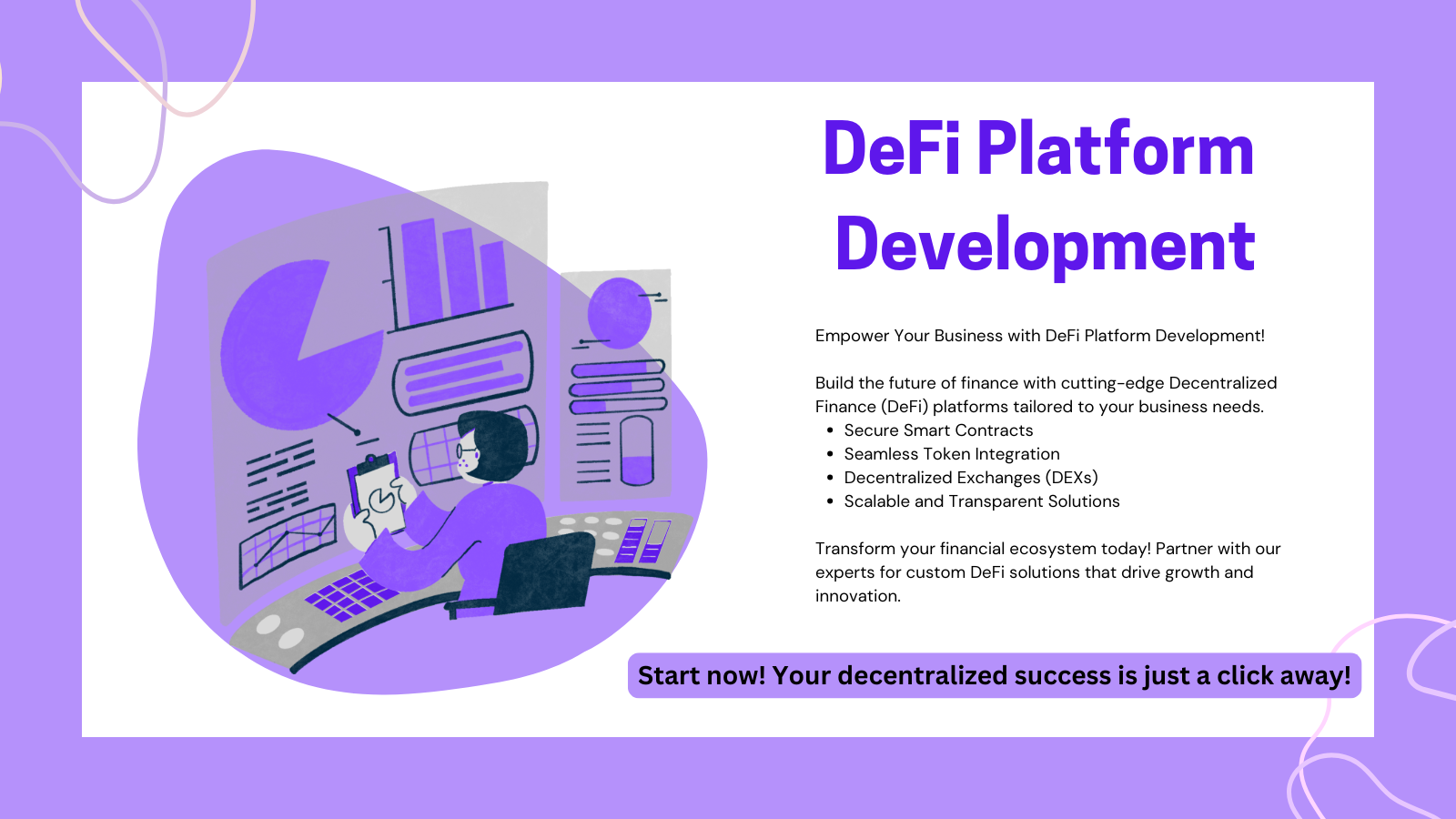The Ultimate Guide to DeFi Platform Development
 flynn rider
flynn rider
Decentralized Finance (DeFi) transforms the financial world by eliminating intermediaries and giving users complete control over their assets. With blockchain technology at its core, DeFi platforms offer secure, transparent, and permissionless financial services like trading, lending, borrowing, and staking. If you’re planning to develop a DeFi platform, this comprehensive guide will walk you through the key aspects of development, benefits, and challenges.
What is a DeFi Platform?
A DeFi platform is a decentralized application (dApp) that provides financial services without traditional banks or financial institutions. These platforms leverage smart contracts to automate transactions, reducing costs and increasing efficiency. Unlike traditional finance, DeFi platforms are open to anyone with an internet connection, making financial services more accessible.
Key Features of a DeFi Platform
Decentralization – Operates without a central authority.
Smart Contracts – Self-executing contracts that ensure security and automation.
Transparency – Transactions are recorded on a public blockchain for complete visibility.
Interoperability – Many DeFi applications work across different blockchains.
Security – Cryptographic encryption ensures funds are safe from unauthorized access.
Liquidity Pools – Users can provide liquidity to earn rewards.
Governance Mechanism – Some platforms allow users to participate in decision-making.
Types of DeFi Platforms
Before starting development, it’s crucial to decide on the type of DeFi platform you want to build:
Decentralized Exchanges (DEXs) – Platforms like Uniswap and PancakeSwap allow peer-to-peer trading without intermediaries.
Lending and Borrowing Platforms – Platforms like Aave and Compound enable users to lend their crypto and earn interest or borrow against their holdings.
Yield Farming and Staking Platforms – These platforms offer rewards for providing liquidity or staking tokens.
Stablecoin Platforms – Cryptocurrencies pegged to stable assets like USD to reduce volatility.
DeFi Insurance – Platforms that provide coverage against smart contract failures and hacks.
Steps to Develop a DeFi Platform
1. Define the Purpose and Features
Start by identifying the purpose of your DeFi platform. Decide on the features and functionalities it will offer, such as trading, staking, yield farming, or lending.
2. Choose the Right Blockchain
Selecting the right blockchain network is crucial for the success of your platform. Some popular options include:
Ethereum – The most widely used blockchain for DeFi projects.
Binance Smart Chain (BSC) – Known for lower fees and faster transactions.
Solana – High-speed blockchain with low fees.
Polygon – Layer-2 scaling solution for Ethereum.
3. Develop Smart Contracts
Smart contracts are the backbone of any DeFi platform. They automate transactions, ensuring security and transparency. When developing smart contracts:
Write secure and efficient code.
Test for vulnerabilities.
Use third-party security audits.
4. Create an Intuitive User Interface (UI/UX)
A user-friendly interface ensures easy navigation and better user experience. Design your platform with:
A responsive and visually appealing interface.
Easy wallet integration (e.g., MetaMask, Trust Wallet).
Clear transaction history and real-time data updates.
5. Implement Security Measures
Security is a major concern in DeFi development. To protect your platform:
Conduct smart contract audits.
Implement multi-factor authentication (MFA).
Use encryption and secure coding practices.
Provide bug bounty programs to identify potential vulnerabilities.
6. Liquidity Management
Liquidity is vital for any DeFi platform. Ensure sufficient liquidity by integrating liquidity pools, incentivizing liquidity providers, and partnering with existing DeFi protocols.
7. Compliance and Regulations
DeFi platforms operate in a rapidly evolving regulatory environment. Stay updated on the legal requirements of different countries and ensure your platform complies with KYC (Know Your Customer) and AML (Anti-Money Laundering) guidelines if required.
8. Testing and Deployment
Before launching, thoroughly test the platform to identify and fix bugs. Conduct beta testing with real users to gather feedback and make improvements. Once testing is complete, deploy the platform on the mainnet.
9. Marketing and User Acquisition
After deployment, focus on marketing strategies to attract users. Some effective strategies include:
Social media marketing
Influencer partnerships
Community building (Telegram, Discord)
Airdrops and reward programs
Benefits of Developing a DeFi Platform
Eliminates Middlemen – Users have direct control over their funds.
Global Accessibility – Anyone with an internet connection can access DeFi services.
Lower Costs – No intermediaries mean reduced transaction fees.
Transparency – Every transaction is recorded on the blockchain.
Passive Income Opportunities – Users can earn rewards through staking and yield farming.
Challenges in DeFi Platform Development
While DeFi platforms offer numerous benefits, they also come with challenges:
Security Risks – Smart contract vulnerabilities can lead to hacks.
Scalability Issues – Network congestion can slow down transactions.
Regulatory Uncertainty – DeFi regulations vary by country and may change over time.
User Education – Many users are new to DeFi and require guidance on how to use the platform safely.
Future of DeFi Platforms
DeFi is rapidly evolving, with new innovations emerging in areas like:
Layer-2 Scaling Solutions – Faster and cheaper transactions.
Cross-Chain Interoperability – Seamless transactions across multiple blockchains.
AI-Powered DeFi – Enhanced risk management and automated trading.
NFT Integration – Tokenizing real-world assets for DeFi applications.
Final Thoughts
Developing a DeFi platform requires careful planning, technical expertise, and a strong focus on security. By following the right development steps and staying updated with the latest trends, you can create a successful DeFi platform that offers users secure and efficient financial services.
If you’re looking to build your own DeFi platform, partnering with experienced blockchain developers can help you bring your vision to life. The future of finance is decentralized—start your journey today!
Contact:
Ready to bring your DeFi to life? Reach out to the team at
WhatsApp - +91 9500575285
Email - hello@coinsclone.com
Subscribe to my newsletter
Read articles from flynn rider directly inside your inbox. Subscribe to the newsletter, and don't miss out.
Written by

flynn rider
flynn rider
I am a Blockchain enthusiast that enjoys talking about cryptocurrencies and their growth. By doing that, I hope to inspire aspiring entrepreneurs to come up with company concepts.